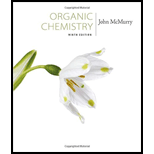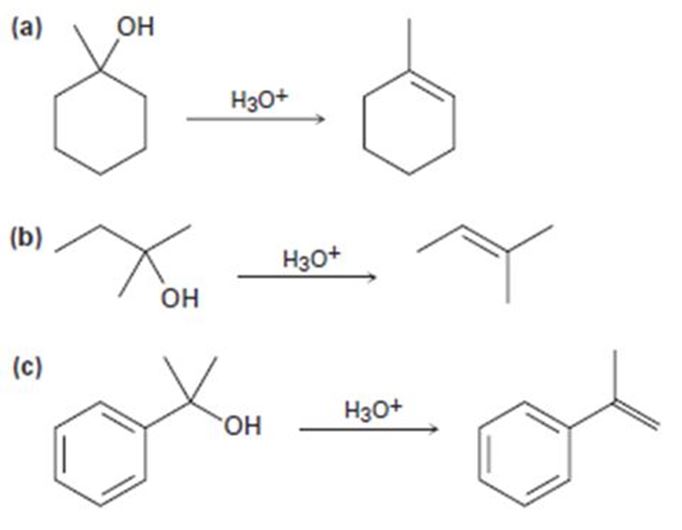
Study Guide with Student Solutions Manual for McMurry's Organic Chemistry, 9th
9th Edition
ISBN: 9781305082144
Author: John E. McMurry
Publisher: Cengage Learning
expand_more
expand_more
format_list_bulleted
Concept explainers
Textbook Question
Chapter 17.SE, Problem 32MP
The conversion of 3° alcohols into

Expert Solution & Answer
Trending nowThis is a popular solution!

Students have asked these similar questions
Using the following two half-reactions, determine the pH range in which $NO_2^-\ (aq)$ cannot be found as the predominant chemical species in water.* $NO_3^-(aq)+10H^+(aq)+8e^-\rightarrow NH_4^+(aq)+3H_2O(l),\ pE^{\circ}=14.88$* $NO_2^-(aq)+8H^+(aq)+6e^-\rightarrow NH_4^+(aq)+2H_2O(l),\ pE^{\circ}=15.08$
Indicate characteristics of oxodec acid.
What is the final product when hexanedioic acid reacts with 1º PCl5 and 2º NH3.
Chapter 17 Solutions
Study Guide with Student Solutions Manual for McMurry's Organic Chemistry, 9th
Ch. 17.1 - Give IUPAC names for the following compounds:Ch. 17.1 - Prob. 2PCh. 17.2 - The following data for isomeric four-carbon...Ch. 17.2 - Rank the following substances in order of...Ch. 17.2 - Prob. 5PCh. 17.3 - Prob. 6PCh. 17.4 - What reagent would you use to accomplish each of...Ch. 17.4 - Prob. 8PCh. 17.5 - Prob. 9PCh. 17.5 - Prob. 10P
Ch. 17.5 - Use the reaction of a Grignard reagent with a...Ch. 17.6 - How would you carry out the following...Ch. 17.6 - What products(s) would you expect from dehydration...Ch. 17.7 - What alcohols would give the following products on...Ch. 17.7 - What products would you expect from oxidation of...Ch. 17.8 - TMS ethers can be removed by treatment with...Ch. 17.9 - Show the mechanism for the reaction of...Ch. 17.11 - Prob. 18PCh. 17.11 - When the 1HNMR spectrum of an alcohol is run in...Ch. 17.SE - Give IUPAC names for the following compounds:Ch. 17.SE - Draw the structure of the carbonyl compound(s)...Ch. 17.SE - Prob. 22VCCh. 17.SE - Prob. 23VCCh. 17.SE - Name and assign R or S stereochemistry to the...Ch. 17.SE - Evidence for the intermediate carbocations in the...Ch. 17.SE - Acid-catalyzed dehydration of 2,...Ch. 17.SE - Prob. 27MPCh. 17.SE - Treatment of the following epoxide with aqueous...Ch. 17.SE - Prob. 29MPCh. 17.SE - Prob. 30MPCh. 17.SE - Identify the type of substitution mechanism (SN1,...Ch. 17.SE - The conversion of 3 alcohols into alkenes under...Ch. 17.SE - Prob. 33MPCh. 17.SE - The trimethylsilyl (TMS) protecting group is one...Ch. 17.SE - When the alcohol below is treated with POCI3 and...Ch. 17.SE - Phenols generally have lower pKa’s than...Ch. 17.SE - Give IUPAC names for the following compounds:Ch. 17.SE - Draw and name the eight isomeric alcohols with...Ch. 17.SE - Prob. 39APCh. 17.SE - Named bombykol, the sex pheromone secreted by the...Ch. 17.SE - Carvacrol is a naturally occurring substance...Ch. 17.SE - What Grignard reagent and what carbonyl compound...Ch. 17.SE - What carbonyl compounds would you reduce to...Ch. 17.SE - What carbonyl compounds might you start with to...Ch. 17.SE - Prob. 45APCh. 17.SE - What products would you obtain from reaction of...Ch. 17.SE - Prob. 47APCh. 17.SE - How would you prepare the following compounds from...Ch. 17.SE - Prob. 49APCh. 17.SE - What products would you expect to obtain from...Ch. 17.SE - Prob. 51APCh. 17.SE - Propose structures for alcohols that have the...Ch. 17.SE - Propose a structure consistent with the following...Ch. 17.SE - The 1HNMR spectrum shown is that of...Ch. 17.SE - A compound of unknown structure gave the following...Ch. 17.SE - Propose a structure for a compound C15H24O that...Ch. 17.SE - Prob. 57APCh. 17.SE - Prob. 58APCh. 17.SE - Rank the following substituted phenols in order of...Ch. 17.SE - Benzvl chloride can be converted into benzaldehvde...Ch. 17.SE - Prob. 61APCh. 17.SE - Prob. 62APCh. 17.SE - Prob. 63APCh. 17.SE - Prob. 64APCh. 17.SE - Prob. 65APCh. 17.SE - Prob. 66APCh. 17.SE - Dehydration of trans-2-methylcyclopentanol with...Ch. 17.SE - 2, 3-Dimethyl-2, 3-butanediol has the common name...Ch. 17.SE - As a rule, axial alcohols oxidize somewhat faster...Ch. 17.SE - Prob. 70APCh. 17.SE - A problem often encountered in the oxidation of...Ch. 17.SE - Identify the reagents a-f in the Following scheme:Ch. 17.SE - Prob. 73APCh. 17.SE - Prob. 74APCh. 17.SE - Compound A, C8H10O, has the IR and 1H NMR spectra...Ch. 17.SE - Prob. 76APCh. 17.SE - Prob. 77AP
Knowledge Booster
Learn more about
Need a deep-dive on the concept behind this application? Look no further. Learn more about this topic, chemistry and related others by exploring similar questions and additional content below.Similar questions
- What is the final product when D-galactose reacts with hydroxylamine?arrow_forwardIndicate the formula of the product obtained by reacting methyl 5-chloro-5-oxopentanoate with 1 mole of 4-penten-1-ylmagnesium bromide.arrow_forwardIn the two chair conformations of glucose, the most stable is the one with all the OH groups in the equatorial position. Is this correct?arrow_forward
- please help me with my homeworkarrow_forwardhelparrow_forwardThe temperature on a sample of pure X held at 1.25 atm and -54. °C is increased until the sample boils. The temperature is then held constant and the pressure is decreased by 0.42 atm. On the phase diagram below draw a path that shows this set of changes. pressure (atm) 2 0 0 200 400 temperature (K) Xarrow_forward
- QUESTION: Answer Question 5: 'Calculating standard error of regression' STEP 1 by filling in all the empty green boxes *The values are all provided in the photo attached*arrow_forwardpressure (atm) 3 The pressure on a sample of pure X held at 47. °C and 0.88 atm is increased until the sample condenses. The pressure is then held constant and the temperature is decreased by 82. °C. On the phase diagram below draw a path that shows this set of changes. 0 0 200 temperature (K) 400 аarrow_forwarder your payment details | bar xb Home | bartleby x + aleksogi/x/isl.exe/1o u-lgNskr7j8P3jH-1Qs_pBanHhviTCeeBZbufuBYT0Hz7m7D3ZcW81NC1d8Kzb4srFik1OUFhKMUXzhGpw7k1 O States of Matter Sketching a described thermodynamic change on a phase diagram 0/5 The pressure on a sample of pure X held at 47. °C and 0.88 atm is increased until the sample condenses. The pressure is then held constant and the temperature is decreased by 82. °C. On the phase diagram below draw a path that shows this set of changes. pressure (atm) 1 3- 0- 0 200 Explanation Check temperature (K) 400 X Q Search L G 2025 McGraw Hill LLC. All Rights Reserved Terms of Use Privacy Cearrow_forward
arrow_back_ios
SEE MORE QUESTIONS
arrow_forward_ios
Recommended textbooks for you

Chapter 4 Alkanes and Cycloalkanes Lesson 2; Author: Linda Hanson;https://www.youtube.com/watch?v=AL_CM_Btef4;License: Standard YouTube License, CC-BY
Chapter 4 Alkanes and Cycloalkanes Lesson 1; Author: Linda Hanson;https://www.youtube.com/watch?v=PPIa6EHJMJw;License: Standard Youtube License